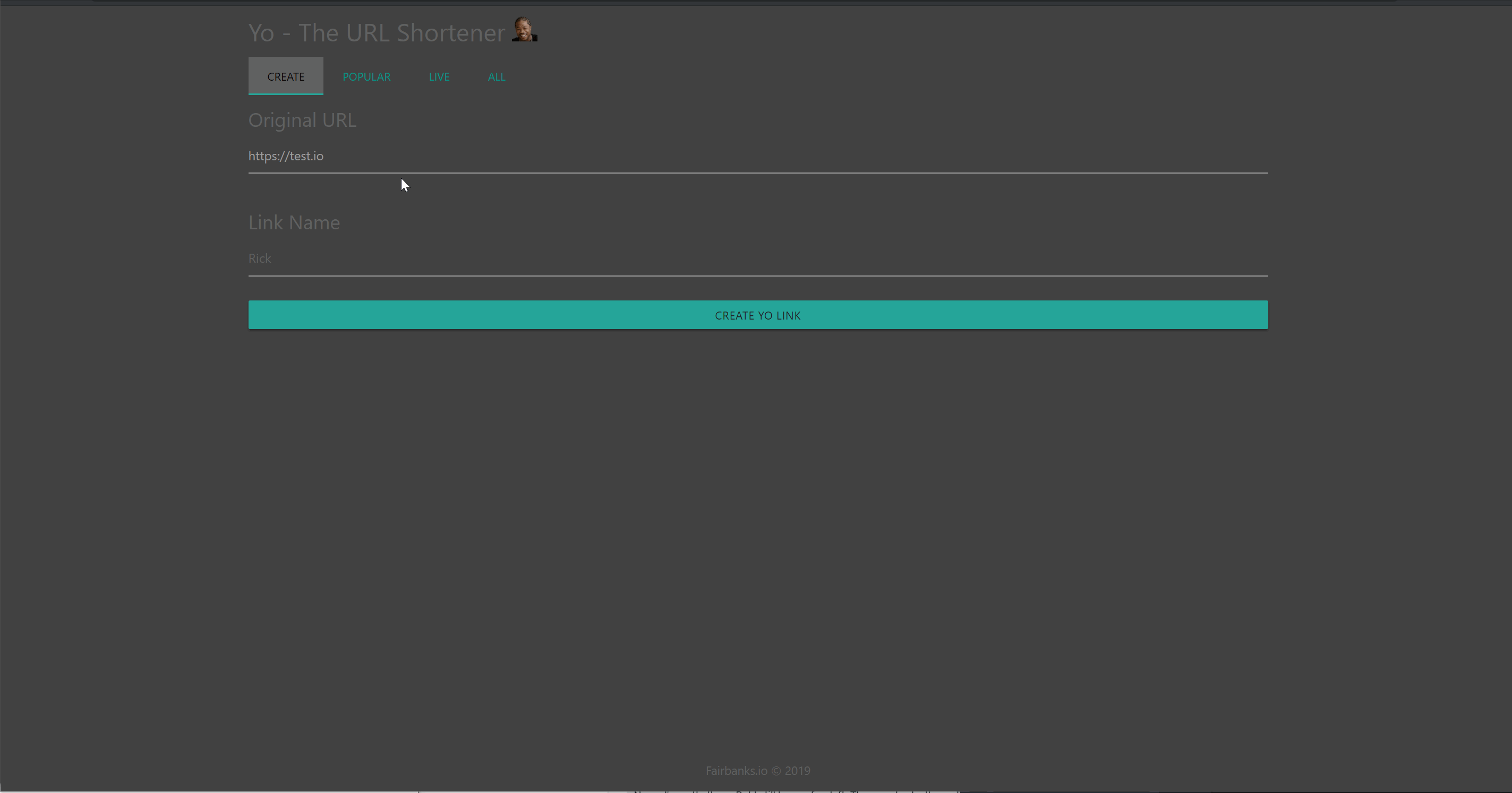Yo Dawg, heard you're tired of remembering URLs
Turn long, hard to remember URLs into easily sharable short-links.
The following will need to be installed before proceeding:
- Node.js
- Mongo DB
# Clone it
git clone https://github.com/jonfairbanks/yo.git
cd yo# Install Dependencies
npm install
# Start Server
npm start
Rename the included .env.sample files to .env and update variables as appropriate for your install.
| ENV | Required? | Details | Example |
|---|---|---|---|
REACT_APP_API_URL |
Yes | Used to connect to the Yo API. Be sure to include the trailing slash. | https://yo-api.mysite.io/api/ |
REACT_APP_SOCKET_URL |
Yes | This will be used to connect to Yo API’s Socket.io endpoint. | https://yo-api.mysite.io |
REACT_APP_BASE_URL |
Yes | The url of the website where Yo is hosted. The slash is not required. | https://yo.mysite.io |
REACT_APP_BLOCKED_NAMES |
No | Comma separated string of words that cannot be used as link names. | "blocked1,blocked2" |
REACT_APP_ALLOWED_NAMES |
No | Comma separated string of words to allow through the filter. A complete list of blocked names can be found here. | "allowed1,allowed2" |
REACT_APP_URL_PLACEHOLDER |
No | Overwrite the default URL placeholder shown on the submit form. | https://www.youtube.com/watch?v=dQw4w9WgXcQ |
REACT_APP_NAME_PLACEHOLDER |
No | Overwrite the default link name placeholder shown on the submit form. | Rick |
REACT_APP_AUTH |
No | Enforces user logins via Auth0. For more details, see the Enabling API Authentication section below. | true |
REACT_APP_SIGNUPS |
No | Forces the ability for users to sign-up during initial login. Not currently recommended. | true |
REACT_APP_AUTH0_CLIENT |
No | Required for Authentication Setup | Provided during Auth0 Setup |
REACT_APP_AUTH0_DOMAIN |
No | Required for Authentication Setup | mysite.auth0.com |
PORT |
No | Override the application port. Defaults to 3000. | 3001 |
| ENV | Required? | Details | Example |
|---|---|---|---|
ERROR_URL |
Yes | Where should users be directed when navigating to an unknown link? (Feature is WIP) | https://mysite.io/error |
BASE_URL |
Yes | The url where Yo client is hosted. The trailing slash is not required. | https://yo.mysite.io |
API_URL |
Yes | The url where Yo client is hosted. The trailing slash is required. | https://yo-api.mysite.io/api/ |
MONGO_URI |
No | What Mongo instance to use. If the ENV is not provided, mongodb://localhost/yo is used. |
mongodb://user:password@localhost:27018/yo |
LOG_LOCATION |
No | Override where the Yo access log is written. By default the log is written into the app directory. | /Logs/yo.log |
AUTH |
No | Enforces token authentication. If enabled, Auth0 should also be enabled on the client side. | true |
AUTH0_DOMAIN |
No | Required to authenticate user tokens. Should match the AUTH0_DOMAIN provided to the client. | mysite.auth0.com |
PORT |
No | Override the application port. Defaults to 7000. | 7001 |
# Move to client Folder
cd client/
# Install Dependencies
npm install
# Start Client
npm start
By default, the Yo backend API is open which would allow anyone who knew your API endpoint to list, edit or even delete links if they chose. To prevent this, you can enable Auth0 authentication for requests between the client and server.
- Sign up for an Auth0 account
- Create and Setup a Regular Web Application. Configure it as you see fit.
- In the Yo config.js files, set the Client and/or Domain provided by Auth0.
- Before leaving Auth0, create a user account for your application under User & Roles.
- Navigate to Yo and login with the previously created user. If successful, you should be logged into the dashboard successfully.
By default, sign-ups via the Auth0 UI are disabled. If you would like to allow user-signup however, you can force this on by passing REACT_APP_SIGNUPS=true during Yo client startup.
Jon Fairbanks - Maintainer Brandon Sorgdrager - Contributer

?label=Client%20Build)
?label=Server%20Build)




